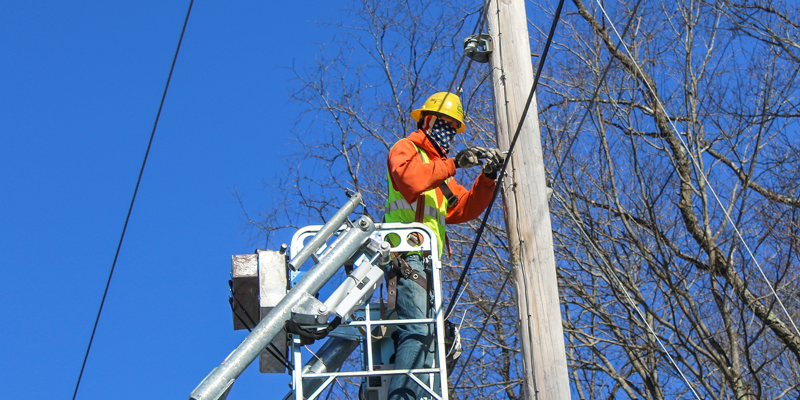Tri-County REC Takes Measured Approach to Broadband

Tri-County Rural Electric Cooperative is one of many cooperatives to enter the broadband business to help meet members’ increasing needs for high-speed internet access while also upgrading its electric system communications.
What sets Tri-County REC apart is the conservative approach it has taken to its investment, securing more than $50 million in funding support, doing substantial financial and market analysis, and embracing a measured approach to deployment.
Headquartered in Mansfield, Pennsylvania, Tri-County REC plans to roll out broadband service to its more than 16,600 members and also to connect its substations in northcentral Pennsylvania over the next six years—all through its wholly owned, for-profit subsidiary, Tri-Co Connections.
Filling the High-Speed Internet Void
“For several years, we had been hearing from our members about the lack of high-speed internet in our area,” Tri-County REC and Tri-Co Connections President and CEO Craig Eccher said. “In the 1930s, the cooperative did what investor-owned utilities refused to do: provide electric service to vast stretches of rural north-central Pennsylvania. Similarly, few companies today have committed to providing quality broadband service across much of our service territory. Once again, Tri-County will bridge that divide.”
Giving it a leg up is the fact Tri-County REC has built a large war chest for its more than 2,700-mile fiber-to-the-home broadband initiative.
The cooperative was awarded $32.3 million over 10 years in the Federal Communications Commission’s (FCC) Connect America Fund II (CAF II) reverse auction in August 2018.
It also received a $1.5 million grant through the Pennsylvania Redevelopment Assistance Capital Project program, $17.1 million of funding through the Pennsylvania Broadband Investment Incentive and a $2.5 million grant by the Appalachian Regional Commission. Together, these funds represent nearly 70 percent of the estimated $77 million project cost.
Market and Feasibility Studies Reduce Risk
Before deciding to enter the broadband business, the cooperative undertook a number of studies to analyze market demand and risk. It surveyed its membership to determine what type of internet service they had and whether it was sufficient for their needs. It also hired a consultant to complete a feasibility study that analyzed the supply and demand for high-speed broadband in its service territory.
“We also completed several financial renditions to assess risk associated with deploying fiber,” Tri-County REC Director of Regulatory Affairs and Economic Development Rachel Hauser explained. “That gave us a clearer picture of what was necessary to make the project financially feasible, better understand areas of risk and develop risk-mitigation strategies as we move forward.”
Phased Approach Provides Flexibility
Phase one of the build-out kicked off in November 2019 and involves construction of about 110 miles of fiber in western portions of Tri-County REC’s service area. When complete this summer, approximately 1,100 residential, seasonal and commercial members will have broadband access from Tri-Co Connections.
Phase two involves building a 464-mile fiber backbone to connect the cooperative’s 25 substations to improve electric system communications and expand smart grid capabilities.
“This will improve fault isolation and allow for enhanced automation,” Eccher said. “These capabilities will allow us to more quickly and cost-effectively restore service during an outage, and allow for live metering to help predict outages. The fiber will also enable our outside crews to have more updated mapping, improve methods of communication between the main office and district buildings, and allow better security at substations and district buildings.”
Beyond the initial phases, there’s also the possibility of expanding the system.
“While our first priority is to serve our members, if there are additional opportunities to serve others who lack high-speed internet, we’re willing to consider that if it’s financially feasible,” Hauser said.
She added that key factors that will help determine whether to expand the project include:
- Overall member satisfaction with the service, combined with a high take rate and low churn, to ensure a continuing return on investment.
- Ability to cost-effectively reach new customers.
- Tangible benefits for the cooperative on the electric side.
CFC Supported Project Milestones
To support the broadband project, CFC provided Tri-County REC with a letter of credit, a bridge line of credit for interim financing and a long-term loan to supplement grant funds received.
“CFC has been a key partner in helping us bring high-speed internet and phone service to our members,” Eccher said. “Not only did CFC work closely with us to assess the financial feasibility of the project, but their intricate knowledge of the FCC CAF II financing requirements was critical in successfully securing the CAF II funding.”
Although its broadband project is still in its early stages, Tri-County REC has already learned some of the key differences between the broadband market and the electricity market.
“Cooperatives know the meaning of hard work and partnering for best results,” Eccher explained. “What was new for us is that we had to really learn a whole new industry and adapt to a completely different, competitive market. That requires a fairly drastic mindset shift and augments the importance of lean business practices.”
Advice to Cooperatives Considering Broadband Services
His advice to other electric cooperatives thinking about entering the broadband market?
“Develop partnerships with experts in the telecommunications industry and utilize those partnerships," he said. "Your cooperative can’t do a project like this alone. Also, prepare for a competitive market by having a strong marketing plan and make sure you have the capacity to market well.”
Published May 18, 2020, in CFC Solutions News Bulletin.